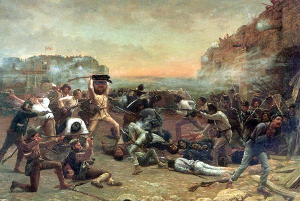The Making of the 50 States: Texas
Part 2: The Rest of the Story 
Texians rebelled against Mexico in 1835. Tensions escalated, and the two sides fought the Battle of Gonzales on October 2. It was a victory for the Texians, who pursued the Mexican force to San Antonio. A few weeks later, on October 28, a group of 90 Texians, including famed outdoorsman Jim Bowie, defeated a force of 450 Mexican soldiers at the Battle of Concepcion. Two months later, on December 11, the Texians won another battle against the Mexicans, capturing San Antonio. The victorious Texians declared independence on March 2, 1836. The Republic of Texas was born. Four days later, a large Mexican force surrounded a group of Texians and other Americans at the Alamo and won a resounding victory. "Remember the Alamo!" became a rallying cry for Texians and Americans, especially after Mexican forces killed nearly 400 in the Goliad Massacre. "Remember Goliad!" also became a rallying cry. A Texian force routed a Mexican force at the Battle of San Jacinto, on April 21. One of the consequences of the battle was that Mexican President Antonio López de Santa Anna was captured. One of the terms of his release was that he sign a treaty that ended the fighting. He did so. 
Sam Houston was the first president of the new Texas Territory. Austin, named for Stephen F., became the Texas capital in 1839. The Texians adopted the Lone Star flag. That wasn't the end of the armed struggle, though. An armed expedition of 320 marched toward Santa Fe in June 1841. They were intercepted by Mexican forces and captured, forced to march 2,000 miles to a prison in Mexico City. They were released the following April. Another expedition occupied the Mexican town of Mier in December 1842. A large Mexican force entered the area, and a a battle ensued; the result was another Texian defeat and another forced march to a Mexican prison. 
At the end of 1842, fearing a Mexican takeover of Austin, a forced led by Texas President Sam Houston went to Austin with the intent of transferring the seat of government and all of its records to the town of Houston. Sam Houston's men found resistance from the residents of Austin, who eventually relented. This confrontation came to be known as the bloodless Archives War. On December 29, 1845, Texas joined the Union, the product of an annexation effort that stretched back years. It wouldn't be long, however, before another chapter in the armed struggle between Texians and Mexicans would begin: the Mexican-American War. First page > In the Beginning > Page 1, 2
|
|
Social Studies for Kids
copyright 2002–2024
David White




